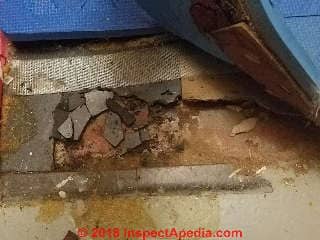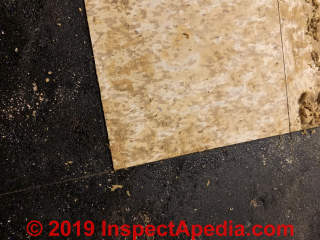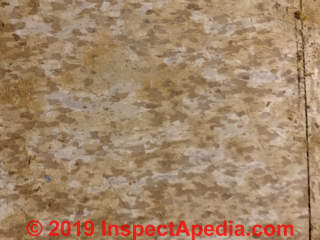 Floor Leveling Compounds & Fillers
Floor Leveling Compounds & Fillers
How to level up a floor surface before installing new tiles or sheet flooring
- POST a QUESTION or COMMENT about how to buy, inspect, troubleshoot, repair resilient flooring
Here we describe using floor leveling compounds or filler tiles to smooth out an old floor surface before covnering-it over with new resilient sheet flooring or floor tiles.
This article series explains the best practices used to install vinyl tile, sheet vinyl, cork floors, and other resilient flooring including modern linoleum.
InspectAPedia tolerates no conflicts of interest. We have no relationship with advertisers, products, or services discussed at this website.
- Daniel Friedman, Publisher/Editor/Author - See WHO ARE WE?
How to Level Up Damaged Tile Floor Surfaces
 Question: What's the best way to level up a floor where just some floor tiles were removed
Question: What's the best way to level up a floor where just some floor tiles were removed
We had a professional asbestos remediation contractor remove all of the old 9x9 asbestos-containing floor tiles from our 1967 home in New Jersey. But the asbestos investigators didn’t catch other 9x9 floor tiles that were under two layers of carpet in this room upstairs.
Given the age, location and history of the home and following your questions
at DOES THIS FLOOR CONTAIN ASBESTOS?
we think that both the floor tiles and the black adhesive mastic contain asbestos - we're certainly treating it as PACM (Presumed Asbestos-Containing-Material) as a good policy.
I ripped up a number of tiles before realizing they were ASB because the carpet and cushion under were covering them.
Now I have a giant “hole” where the tiles were and I want to put flooring down over it. Do you have any recommendations for covering the “hole” left after this stuff came up?
We’re talking like 1/16th to 1/32 of a difference which is small but over the years will look like bowing/sinking. - Anonymous by private email 2019/11/09
Reply: installing resilient sheet flooring: how best to smooth out area where some floor tiles were removed
I can forgive your asbestos inspector - in part - for not catching the presence of asbestos-suspect floor tiles under two other layers of flooring materials, though it might have been prudent for the inspector warn you that given the age of the home and having found some vinyl asbestos floor tiles in one location there could well be others under some of the newer-looking carpets or other floor coverings.
And before paying for an expensive floor removal in one room I might have pulled up the carpet to take a look.
On the other hand, nyah: bottom line: it's least expensive and safest to leave old asbestos-containing flooring alone, in-place, and to cover it over if at all possible.
OK so what do we do now with your uneven asbestos-suspect tiled floor?
Step 1: clean the existing floor
This mean removing loose floor tiles, fragments, dust and debris.
Watch out: do not run a home vacuum cleaner or shop vacuum cleaner on asbestos-suspect materials as you may simply send small harmful asbestos particles into the air. Use a HEPA vacuum cleaner.
Details are at ASBESTOS FLOORING REMOVAL GUIDE
Step 2: level the existing floor
If the floor has minor irregularities such as an occasional fragment of floor tile missing, what you need to do depends on what type of new flooring will be installed.
If you are installing a thick new floor underlayment (such as solid core plywood) or thick new flooring material such as wood floorboards or laminate flooring, you may not need to do more to the existing floor surface (except be sure it's clean and dry and that there is no ongoing moisture or water entry problem.
If you are installing new floor tiles of any type or new resilient sheet flooring you will want the old floor surface to be prepared: it needs to be quite smooth so that irregularities don't telegraph up through and create wear spots in the new floor covering.
This article addresses this problem below as we describe approaches to leveling out the floor surface.
Step 3: Seal the floor surface
If you are going to install leveling compound or if you plan to glue down replacement floor tiles to smooth out the old floor surface you may want to paint or seal the exposed floor mastic (where old floor tiles were removed) for a better bond with the filler.
Watch out: for good adhesion of floor leveling compound, patches, or filler tiles where old floor tiles are missing, you may want to paint the exposed cutback adhesive surface with a sealant to help assure that the filler tile or leveling compound bond well.
See FLOORING ADHESIVE MASTIC SEALANTS - a separate article. Read that and return here.
Paint the whole old floor with epoxy? We sometimes choose paint the whole floor with an epoxy floor paint rather than installing a layer of new flooring. To follow that approach see the advice given at ASBESTOS FLOORING LEFT IN PLACE.
Readers have noted that even when most of the old floor tiles (asbestos-suspect or not) are well-adhered and can remain in place, there may be a few spots where tiles have come up or have been removed, leaving an un-even floor surface that can not just be covered over with sheet vinyl or new vinyl floor tiles. Those spots need to be filled first.
Step 4. install the new flooring
So instead of painting we have decided to install a new floor covering, as we agreed that the cork-pattern 9x9 vinyl floor tile in your two photos should be treated as PACM, given the age of the home, its history as you report, and the age of the floor suggested as well by the use of black mastic adhesive (that may also contain asbestos).
More on that is at ASBESTOS-CONTAINING ADHESIVES
Install new sheet vinyl? From our discussion I am assuming that rather than using an expoxy floor paint you plan to put down sheet vinyl, since heavier flooring such as a laminate or wood would of course never see a 1/16" variation in surface height.
Watch out: typically old vinyl-asbestos floor tiles are indeed thin but not 1/16" as you describe; more likely the flooring was usually 1/8" thick (referred to as " Type 1 Semi-Flexible VInyl Plastic Floor Tile 1/8" Gauge" in Armstrong's catalogs, or sometimes 5/32" thick. Older asphalt-asbestos floor tiles were indeed thicker, as much as 1/4" thick in some products.
See details at ASBESTOS FLOOR TILE DIMENSIONS
In your situation I either find an inexpensive vinyl sheet flooring of exactly the right thickness that I glue down, cut to fit in the openings where old tiles have been lost or removed,
OR
I use a floor leveling compound such as the Henry product shown here. I like Henry's products, having just used their magic roof patching compound yesterday to complete a leak repair in an EPDM roof on a New York home during wet, below-freezing weather.
 In my view if we taper out a difference in floor level over a distance of 18" or more between the two levels (that's the drywall standard) then the human eye will not generally be able to detect the variation (nor will the eye's brain).
In my view if we taper out a difference in floor level over a distance of 18" or more between the two levels (that's the drywall standard) then the human eye will not generally be able to detect the variation (nor will the eye's brain).
When I've done this I use a 12" or wider drywall knife as my spreader.
The only concern I have remaining is whether there's an adhesion issue. The leveling compound has to stick to whatever's on the floor surface lest it later crack and move around.
It's good practice to use a sheet underlayment over the whole floor.
[Click to enlarge any image]
That also protects against any telegraphing from below); there's an ocean of products ranging from thin moisture barriers to expensive sound-deadening cork sheets.
On some buildings with much worse floors I've installed solid plywood underlayment but it doesn't sound like that's approp riate in your case.
Watch out: before putting down a floor leveling compound you need the surface to be dry and free of loose debris, but don't vacuum unless your vac is HEPA-rated.
Floor leveling compounds & products
For a large floor area or an entier floor surface that needs leveling and has many irregularities or that is in generally poor condition you might consider preparing a finish floor surface by using
a POURED-IN-PLACE FLOORING, RESILIENT - these products cover the entire floor and produce a finished, walking surface.
For damaged floors or floors with a smaller number of missing tiles, holes, dings, you might consider a floor leveling compound.
Watch out: before proceeding to install an underlayment and then the new vinyl sheet flooring over the old floor, double check that there are no loose floor tiles that may come up later, annoying everybody.
If the old floor tiles were glued directly to a concrete slab or even on the wood subfloor of an upper-level floor in your home you can crawl around (wearing a pair of those nice gel kneepads) tapping on any suspect-looking floor tiles with a soup spoon.
You'll be amazed to notice what a different (lighter, thinner, tinnier) sound the spoon will make if it's tapping on the surface of a floor tile that's not solidly bonded to the slab below.
That's because there's a bit of air space there. (In another article here we describe dragging a chain around on the garage floor or on other slabs to find voids below where water has carried off original backfill, but for this purpose I like the soup spoon.)
Examples of underlayments for sheet flooring
Keep me posted on what snafus arise and send along photos of your job at each stage if you will - that will assist other readers.
...
Continue reading at ASBESTOS FLOORING LEFT IN PLACE or select a topic from the closely-related articles below, or see the complete ARTICLE INDEX.
Or see these
Recommended Articles
- ASBESTOS-CONTAINING ADHESIVES
- ASBESTOS FLOORING HAZARD REDUCTION - home
- ASBESTOS FLOORING IDENTIFICATION
- ASBESTOS FLOORING HAZARD LEVEL ASSESSMENT
- ASBESTOS DISPOSAL REGULATIONS
- ASBESTOS FLOORING LEFT IN PLACE using an expoxy floor paint over asbestos-containing floor tiles or sheet flooring.
- ASBESTOS FLOORING REMOVAL GUIDE
- ASBESTOS LEFT in PLACE in BUILDINGS - MANAGEMENT GUIDES - codes, regulations, procedures
- ASBESTOS REMOVAL, WETTING GUIDELINES
- DOES THIS FLOOR CONTAIN ASBESTOS?
- FLOOR TILE BASE LEVELING describes using leveling compounds or filler-tiles before flooring-over asbestos tile floors
- FLOORING ADHESIVE MASTIC SEALANTS - if you need to glue down new floor or add a leveling compound over old tile mastic
- POURED-IN-PLACE FLOORING, RESILIENT
- RESILIENT FLOORING VINYL or CORK installation
Suggested citation for this web page
FLOOR TILE BASE LEVELING at InspectApedia.com - online encyclopedia of building & environmental inspection, testing, diagnosis, repair, & problem prevention advice.
Or see this
INDEX to RELATED ARTICLES: ARTICLE INDEX to BUILDING FLOORING
Or use the SEARCH BOX found below to Ask a Question or Search InspectApedia
Ask a Question or Search InspectApedia
Try the search box just below, or if you prefer, post a question or comment in the Comments box below and we will respond promptly.
Search the InspectApedia website
Note: appearance of your Comment below may be delayed: if your comment contains an image, photograph, web link, or text that looks to the software as if it might be a web link, your posting will appear after it has been approved by a moderator. Apologies for the delay.
Only one image can be added per comment but you can post as many comments, and therefore images, as you like.
You will not receive a notification when a response to your question has been posted.
Please bookmark this page to make it easy for you to check back for our response.
IF above you see "Comment Form is loading comments..." then COMMENT BOX - countable.ca / bawkbox.com IS NOT WORKING.
In any case you are welcome to send an email directly to us at InspectApedia.com at editor@inspectApedia.com
We'll reply to you directly. Please help us help you by noting, in your email, the URL of the InspectApedia page where you wanted to comment.
Citations & References
In addition to any citations in the article above, a full list is available on request.
- Steve Bliss's Building Advisor at buildingadvisor.com helps homeowners & contractors plan & complete successful building & remodeling projects: buying land, site work, building design, cost estimating, materials & components, & project management through complete construction. Email: info@buildingadvisor.com
Steven Bliss served as editorial director and co-publisher of The Journal of Light Construction for 16 years and previously as building technology editor for Progressive Builder and Solar Age magazines. He worked in the building trades as a carpenter and design/build contractor for more than ten years and holds a masters degree from the Harvard Graduate School of Education. Excerpts from his recent book, Best Practices Guide to Residential Construction, Wiley (November 18, 2005) ISBN-10: 0471648361, ISBN-13: 978-0471648369, appear throughout this website, with permission and courtesy of Wiley & Sons. Best Practices Guide is available from the publisher, J. Wiley & Sons, and also at Amazon.com - Our recommended books about building & mechanical systems design, inspection, problem diagnosis, and repair, and about indoor environment and IAQ testing, diagnosis, and cleanup are at the InspectAPedia Bookstore. Also see our Book Reviews - InspectAPedia.
- In addition to citations & references found in this article, see the research citations given at the end of the related articles found at our suggested
CONTINUE READING or RECOMMENDED ARTICLES.
- Carson, Dunlop & Associates Ltd., 120 Carlton Street Suite 407, Toronto ON M5A 4K2. Tel: (416) 964-9415 1-800-268-7070 Email: info@carsondunlop.com. Alan Carson is a past president of ASHI, the American Society of Home Inspectors.
Thanks to Alan Carson and Bob Dunlop, for permission for InspectAPedia to use text excerpts from The HOME REFERENCE BOOK - the Encyclopedia of Homes and to use illustrations from The ILLUSTRATED HOME .
Carson Dunlop Associates provides extensive home inspection education and report writing material. In gratitude we provide links to tsome Carson Dunlop Associates products and services.




